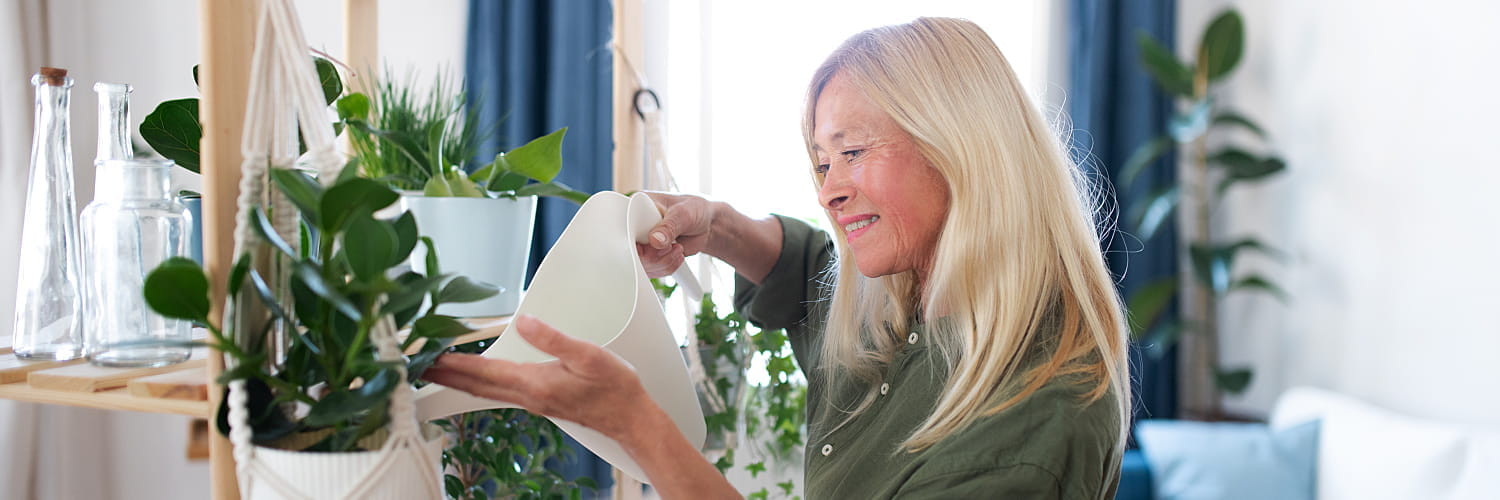If you're looking for a new pastime to enjoy during retirement, gardening is one of the easiest retirement hobbies to start. It's not just easy to start growing your own plants — it could benefit your health and wellness, too. And the good news is that you don't need a large outdoor garden or even a backyard to get started — you can begin with indoor potted plants.
Here's a quick guide to houseplants for beginners.
The Benefits of Houseplants
Indoor gardening and caring for houseplants is a good way for retirees to keep busy when living in a small space or during times of social distancing. Like other retirement hobbies, such as fiber crafting, woodworking, walking and yoga, gardening can help you relax and boost your physical and mental wellness. According to the British medical journal Clinical Medicine, gardening is beneficial to physical and mental health, and it has been associated with a lower risk of dementia.
Adding houseplants to your living space has other benefits, too. A houseplant can add a splash of color that livens up and personalizes a room otherwise decorated in muted colors. Psychologically, a houseplant can remind you of nature and of warmer seasons spent outdoors, when plants and flowers are in bloom, which can improve your mood, Time reports. And a January 2020 study from the University of Hyogo in Japan showed that simply looking at a houseplant can reduce stress.
Getting Started
If growing houseplants is completely new to you, you might want to invest in a book on houseplants for beginners. In the meantime, these tips can help you get growing.
- Note the sunny and shady spots in your home and any drafty areas. Most plants need at least some sunlight, and some plants don't do well in drafty areas. Make sure that you have a plant stand, a shelf or a stable tabletop for your plants.
- Choose a hardy houseplant that's easy to care for as your first indoor potted plant. (We have some suggestions below.)
- Select one or two plants from a local nursery or greenhouse. Your nearby supermarket might also have small potted houseplants that are good for beginner gardeners.
- Read up on how much sunlight, water and soil your plants will need.
Once you've mastered growing one or two plants, you can expand your indoor garden.
Best Houseplants for Beginners
Start with plants that are hardy and easy to care for and do well in any amount of sunlight. Some good options to consider include:
- Golden pothos: It's easy to root in a glass of water, grows quickly and is good for hanging baskets.
- Spider plant: It does well in all lighting situations and grows quickly to produce smaller clumps of leaves that can be repotted for new plants.
- Snake plant: The snake plant and the similar mother-in-law's tongue are very tough plants that need sunlight but don't need much watering.
- Any plant in the dracaena family: These are spikey, and they tolerate a variety of temperatures.
- Any kind of potted succulent or cactus: Agave and aloe are especially easy to look after and are good choices for beginners.
The optimal number of potted houseplants is one for every 100 square feet of living space. So if you're living in a 2,000-square-foot home, try working your way up to 20 plants.
As retirement hobbies go, caring for houseplants is simple and inexpensive, but rewarding. There are many health benefits to keeping plants, and it's a good hobby for retirees who are housebound or have limited mobility. Choose a good spot in your home, select a plant, water it as needed and enjoy!


 Sarita Harbour
Sarita Harbour










